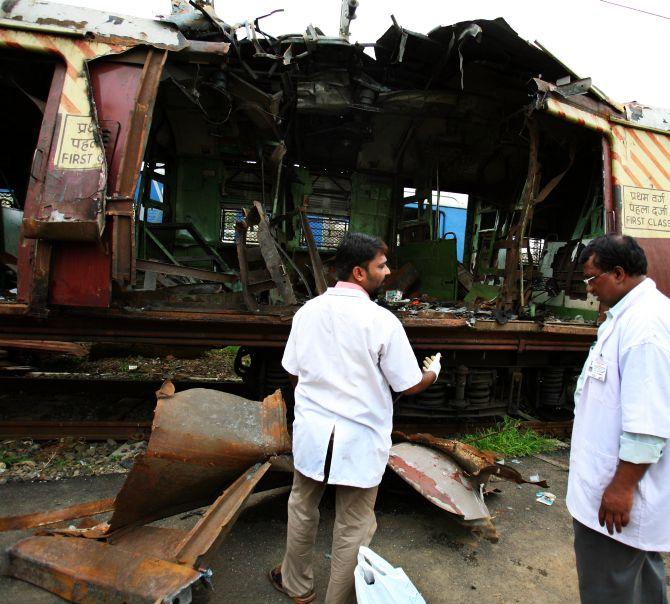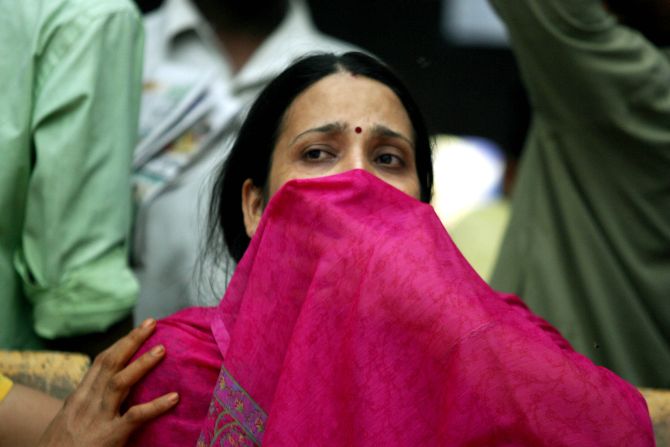 | « Back to article | Print this article |
How Yasin Bhatkal boosted ATS' probe of Mumbai train blasts
In a breather for the Maharashtra ATS, terror mastermind Yasin Bhatkal has confirmed to his interrogators that Gujaratis travelling in first class compartments of Mumbai locals were the target of 2006 train bombings as the IM wanted to avenge the 2002 Gujarat riots. Vicky Nanjappa reports.
The interrogation of arrested Indian Mujahideen co-founder Yasin Bhatkal has given the Maharashtra police a ray of hope as they try and make sense out of the horrific 2006 train bombings in Mumbai in which 209 persons lost their lives and over 700 injured.
The Anti Terrorism Squad had concluded after investigations that it was the Indian Muhjahideen which carried out the blasts in a bid to avenge the 2002 communal riots in Gujarat. However the case went into a limbo after several accused in the custody of the ATS retracted their statements before the magistrate and stated that they had only confessed to their crimes under duress.
Bhatkal, who came into the picture only after 2007, however claimed that he knew about the attack. He told a team of National Investigation Agency interrogators that it was IM chief Riyaz Bhatkal who supplied the material for the blasts at the behest of the Lashkar-e-Tayiba who had by 2006 decided to fight a proxy war under the name of a homegrown Indian outfit, sources told Rediff.com.
Yasin said that this for the first time that the Indian Mujahideen was carrying out such a major operation in India. The trail of the intelligence and the police was on the Lashkar-e-Tayiba operatives, but the IM did finally manage to dodge them by using the Azamgarh module from Uttar Pradesh. This was a brand new terror module and there was hardly any information on them which only made their job easier, Yasin Bhatkal told the NIA, sources revealed.
Please click NEXT to read further…
Bhatkal's revelations major fillip for ATS' probe
The ATS had claimed that they had cracked the case. However, the problem that the agency faced was that they had based the entire case solely on the confessional statement of Sadiq Shaikh who had stated that the operation was jointly carried out by him and Riyaz Bhatkal. However, he retracted the statement later and was termed hostile by the defence.
The ATS faced more problems with the lawyers for the accused arguing that all the confessional statements were extracted through threats. The ATS claimed that it had call records of other accused namely Ehtesham Siddiqui, Faisal Sheikh and Asif Khan Bashir Khan. However, they were unable to produce these call records before the court and stated that it had been destroyed.
As per the original case of the ATS, the prime accused was Kamal Ahmed Mohammad. He was one of the first to retract his statement. Apart from Kamal Ahmed the other accused who have retracted their statements are Faisal Sheikh Ataur Rehman, Ehtisham Siddiqui, Dr Tanveer Ahmed Mohd Ibrahim Mohd Majeed, Mohd Shafi, Mohd Sajid, Margub Ansari, Muzzamil Ataur Rehman Shaikh, Shaikh Mohammad Ali Alam Shaikh, Suhail Mehmood Shaikh, Asif Khan and Bashir Khan.
Please click NEXT to read further…
'IM wanted to avenge the Gujarat riots, was under wraps till 2007'
What Yasin has been telling the investigation agencies is nothing new and it is not as though the ATS has not said this before. According to Yasin, the material for the train blasts was supplied by Riyaz Bhatkal and the arrangements for the same were made from Karachi. The material was facilitated to Riyaz through a person named Mullah Jalaudin alias Babu Bhai, Yasin told his interrogators.
The Gujarat riots was the excuse for the blasts and the aim was to target the first class compartments in the trains since their logistic survey showed that a lot of Gujarati businessmen travelled in those compartments. The material landed in Azamgarh and the same was assembled there. It was prepared by Ariz Khan and Arif Badar and then transported to the blast site.
The planning of these blasts commenced in 2005. It was basically one of the first major operations for the Indian Mujahideen, Yasin said. However, they decided to announce themselves publicly only after the Uttar Pradesh court blasts in 2007.
The IM was well aware that none of the agencies had their data and hence it was not possible to keep a tab on them. This helped the IM carry out the blast with a great deal of ease, he said.
After the blasts the finger pointed towards the Lashkar-e-Tayiba and Pakistan’s Inter Services Intelligence never wanted the name of any Pakistan based-outfit to figure in an Indian investigation. However, it was a conscious decision to keep the name of the IM under wraps after the train blasts.
“It was only when the heat on the Lashkar began to increase, we decided that it was time to announce the IM to the world”, Yasin Bhatkal also told his interrogators.
An officer who was associated with the 2006 train blast investigation told Rediff.com that they had expected that all the accused would retract their statements. “It was only after a year that we realised that it was a home-grown outfit behind this attack,” the officer said.
“We hope to question Yasin Bhatkal soon in connection with these blasts. Although he was not part of it, it appears that he knows quite a lot about it. However the more important person to question in this case would be Assadullah Akthar, an accomplice of Yasin who hails from Azamgarh and this was the module that was activated and used for the attack”, the officer pointed out.


